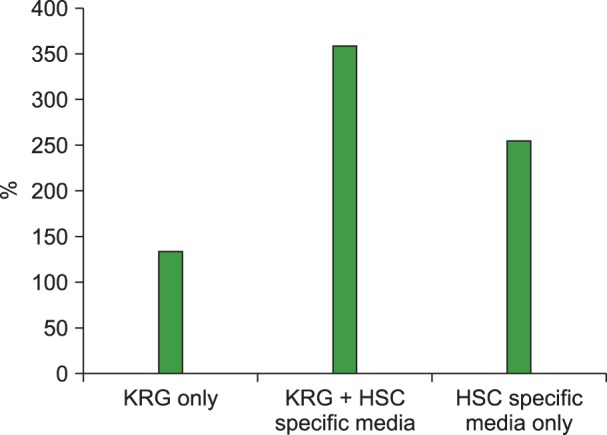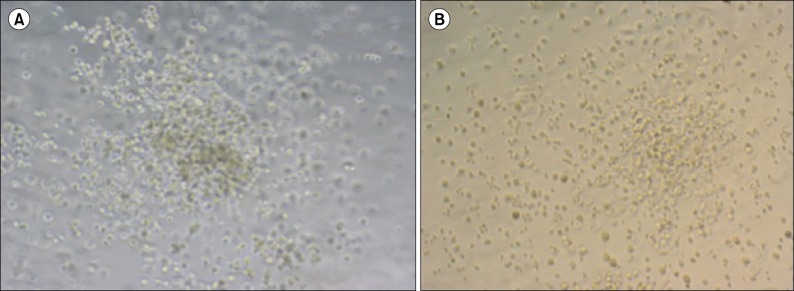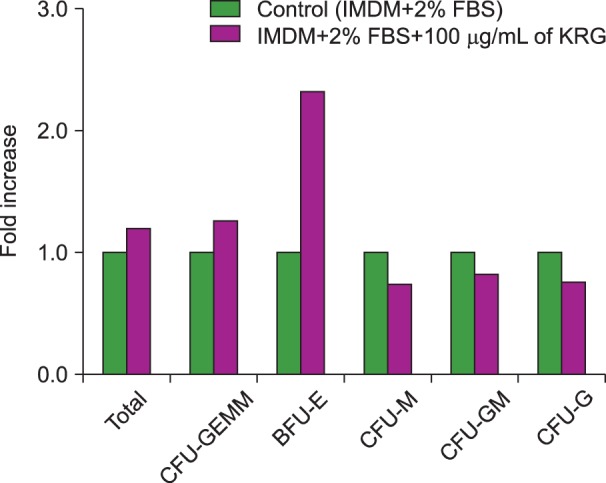Blood Res.
2014 Sep;49(3):177-181. 10.5045/br.2014.49.3.177.
Total extract of Korean red ginseng facilitates human bone marrow hematopoietic colony formation in vitro
- Affiliations
-
- 1Department of Laboratory Medicine, Catholic University of Daegu, School of Medicine, Daegu, Korea. ajlee388@gmail.com
- 2Division of Hematology/Oncology, Department of Internal Medicine, Catholic University of Daegu, School of Medicine, Daegu, Korea.
- 3Department of Oriental Internal Medicine of Hepatology, College of Oriental Medicine and Daegu Hanny University, Daegu, Korea.
- KMID: 2172789
- DOI: http://doi.org/10.5045/br.2014.49.3.177
Abstract
- BACKGROUND
The number of CD34+ cells in a peripheral blood stem cell collection is the key factor in predicting successful treatment of hematologic malignancies. Korean Red Ginseng (KRG) (Panax ginseng C.A. Meyer) is the most popular medicinal herb in Korea. The objective of this study was to determine the effect of KRG on hematopoietic colony formation.
METHODS
Bone marrow (BM) samples were obtained from 8 human donors after acquiring informed consent. BM mononuclear cells (MNCs) were isolated, and CD34+ cells were sorted using magnetic beads. The sorted CD34+ cells were incubated with or without total extract of KRG (50 microg/mL, 100 microg/mL) or Ginsenoside Rg1 (100 microg/mL), and the hematopoietic colony assay was performed using methylcellulose semisolid medium. The CD34+ cell counts were measured by a single platform assay using flow cytometry.
RESULTS
The numbers of human BM-MNCs and CD34+ cells obtained after purification were variable among donors (5.6x10(7) and 1.3-48x10(7) and 8.9x10(4) and 1.8-80x10(4), respectively). The cells expanded 1,944 times after incubation for 12 d. Total extract of KRG added to the hematopoietic stem cell (HSC)-specific medium increased CD34+ cell counts 3.6 times compared to 2.6 times when using HSC medium alone. Total numbers of hematopoietic colonies in KRG medium were more than those observed in conventional medium, especially that of erythroid colonies such as burst forming unit-erythroid.
CONCLUSION
Total extract of KRG facilitated CD34+ cell expansion and hematopoietic colony formation, especially of the erythroid lineage.
MeSH Terms
Figure
Reference
-
1. Specchia G, Pastore D, Mestice A, et al. Early and long-term engraftment after autologous peripheral stem cell transplantation in acute myeloid leukemia patients. Acta Haematol. 2006; 116:229–237. PMID: 17119322.
Article2. Nielsen JS, McNagny KM. CD34 is a key regulator of hematopoietic stem cell trafficking to bone marrow and mast cell progenitor trafficking in the periphery. Microcirculation. 2009; 16:487–496. PMID: 19479621.
Article3. Nakamura R, Bahceci E, Read EJ, et al. Transplant dose of CD34(+) and CD3(+) cells predicts outcome in patients with haematological malignancies undergoing T cell-depleted peripheral blood stem cell transplants with delayed donor lymphocyte add-back. Br J Haematol. 2001; 115:95–104. PMID: 11722418.
Article4. Ergene U, Cagirgan S, Pehlivan M, Yilmaz M, Tombuloglu M. Factors influencing engraftment in autologous peripheral hematopoetic stem cell transplantation (PBSCT). Transfus Apher Sci. 2007; 36:23–29. PMID: 17292672.
Article5. Papajik T, Pikalova Z, Raida L, et al. Rituximab does not adversely affect the stem cell mobilization and engraftment after high-dose therapy and autologous transplantation in patients with diffuse large B-cell lymphoma in first complete or partial remission. Biomed Pap Med Fac Univ Palacky Olomouc Czech Repub. 2009; 153:211–214. PMID: 19851434.
Article6. Keane C, Gibbs S, Seymour JF, et al. The Hyper-CVAD chemotherapy regimen has an adverse long-term impact on the ability to mobilize peripheral blood stem cells, which can be readily circumvented by using the early cycles for mobilization. Hematol Oncol. 2006; 24:159–163. PMID: 16775841.
Article7. Yun TK. Experimental and epidemiological evidence on non-organ specific cancer preventive effect of Korean ginseng and identification of active compounds. Mutat Res. 2003; 523-524:63–74. PMID: 12628504.
Article8. Ernst E. Panax ginseng: an overview of the clinical evidence. J Ginseng Res. 2010; 34:259–263.
Article9. Chen S, Liu J, Liu X, et al. Panax notoginseng saponins inhibit ischemia-induced apoptosis by activating PI3K/Akt pathway in cardiomyocytes. J Ethnopharmacol. 2011; 137:263–270. PMID: 21619920.
Article10. Kim HD, Ha SE, Kang JR, Park JK. Effect of Korean red ginseng extract on cell death responses in peroxynitrite-treated keratinocytes. J Ginseng Res. 2010; 34:205–211.
Article11. Kim EH, Lee MJ, Kim IH, Pyo S, Choi KT, Rhee DK. Anti-apoptotic effects of red ginseng on oxidative stress induced by hydrogen peroxide in SK-N-SH cells. J Ginseng Res. 2010; 34:138–144.
Article12. Gao RL, Chen XH, Lin XJ, Qian XD, Xu WH, Chong BH. Effects of notoginosides on proliferation and upregulation of GR nuclear transcription factor in hematopoietic cells. Acta Pharmacol Sin. 2007; 28:703–711. PMID: 17439727.
Article13. Chen D, Zuo G, Li C, et al. Total saponins of Panax ginseng (TSPG) promote erythroid differentiation of human CD34+ cells via EpoR-mediated JAK2/STAT5 signaling pathway. J Ethnopharmacol. 2009; 126:215–220. PMID: 19735711.
Article14. Wang JW, Wang YP, Wang SL, Jiang R. Synergistic effects of total saponins of panax ginseng in combination with hematopoietic growth factor on proliferation and differentiation of CD34(+) cells ex vivo. Zhongguo Shi Yan Xue Ye Xue Za Zhi. 2006; 14:959–963. PMID: 17096897.15. Kim SG, Jeon CH, Suh HS, Choe JY, Shin IH. P-glycoprotein expression in extracellular matrix formation of chondrogenic differentiation of human adult stem cells. Cell Biol Int. 2007; 31:1042–1048. PMID: 17468018.
Article16. Marinov I, Luxova A, Tkacova V, Gasova Z, Pohlreich D, Cetkovsky P. Comparison of three single platform methods for CD34+ hematopoietic stem cell enumeration by flow cytometry. Clin Lab. 2011; 57:1031–1035. PMID: 22239039.17. Ngoma A, Saito S, Ohto H, et al. CD34+ cell enumeration by flow cytometry: a comparison of systems and methodologies. Arch Pathol Lab Med. 2011; 135:909–914. PMID: 21732782.
Article18. Kim SG, Suh HS, Lee JW, et al. Optimization of retrovirus mediated-gene transfer into hematopoietic stem cells. Korean J Biotechnol Bioeng. 1999; 14:593–599.
- Full Text Links
- Actions
-
Cited
- CITED
-
- Close
- Share
- Similar articles
-
- The Effect of Cord Blood Plasma on Hematopoietic Colony Formation
- Effects of Ginseng on the Metabolism of Enflurane and Methoxyflurane
- Hematopoietic effect of deer antler extract fermented by Bacillus subtilis on murine marrow cells
- Serum Stem Cell Factor (SCF) Levels and In Vitro Response of Hematopoietic Progenitors to Recombinant Human SCF (rhSCF) in Patients with Aplastic Anemia
- Megakaryocyte Colony Formation According to the Origin of Hematopoietic Stem Cell




